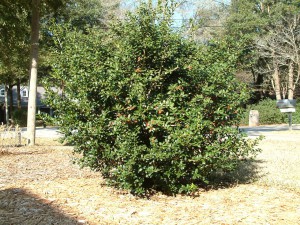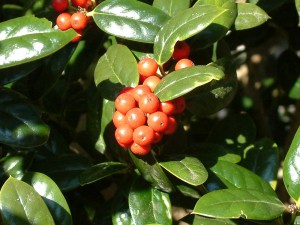Looking for a new shrub or small tree this year? Interested in one that is low maintenance and offers beautiful green color? Why not try a holly.
Hollies can be found in landscapes throughout North Florida. Many times these plants are used in foundation plantings around homes. They can help make the transition from the hard lines of a home to other parts of the yard. In other landscapes, hollies make an excellent screen, dividing property or blocking a view.
Because hollies are commonplace, they may be overlooked by homeowners who want to add an attractive new plant to the landscape. Hollies have many uses and there are new selections entering the market worth considering.
In general hollies will not need a great amount of maintenance. Once established most species will require only occasional water, fertilizer, and pruning. Many hollies have even grown well under neglected conditions. If you are one that keeps holly plants pruned as hedges, you will need to watch for the scale insect and spray plants with a horticultural oil every year.
When selecting a holly plant, it is good to know a little about the area where you want to place the plant. Hollies vary in size and ability to tolerate wet soil, so it is important to match a species with your specific site. Also consider holly leaf shapes when using the plants in areas where people walk. Some holly leaves are very stiff and sharp and could injury visitors to you home or be a nuisance when you are working in the yard.
If you are interested in the added beauty of holly berries during the year, remember to select a female plant.
Tree form hollies that you may select include the American holly (Ilex opaca), Savannah holly (Ilex x attenuata ‘Savannah’), and the Burford holly (Ilex cornuta ‘Burfordii’). All three plants will need well-drained soil. The American and Savannah holly will both reach heights between 20 and 40 feet and have a pyramidal growth form. The Savannah holly leaves will be a lighter green color than the leaves of other holly species. Burford holly has thick dark green leaves and grows about 12-15 feet in height over time.

Burford holly is a beautiful holly that gives birds a place to hide.
Credit: Beth Bolles, UF IFAS Extension Escambia County
If you have a wet site, consider the Dahoon holly which can be a specimen plant or used as a screen. This plant will develop attractive grayish bark and grow about 20 feet in height with more of a spread than the previously mentioned hollies.
There are medium-sized hollies that make excellent specimen plants about 12 feet in height. ‘Festive’ holly has dark green foliage and forms dense growth in a pyramidal form. The ‘Robin’ holly has a similar growth form but displays beautiful reddish new growth. Both of these plants will need well-drained soil and full sun or partial shade.
For those areas that require smaller evergreen plants, consider a ‘Bordeaux’ yaupon holly. These plants will grow about 4 feet in height and spread and form a dense growth of stiff stems with small leathery leaves. Since these plants keep a naturally round form it is not necessary to shear them. Both hollies will tolerate a wide range of soil conditions and require little maintenance once established.
- Garden Spider Egg Sacs - October 23, 2025
- Saving Malabar Spinach Seeds - October 17, 2025
- Improve Butterfly Habitat with Trees - September 18, 2025

